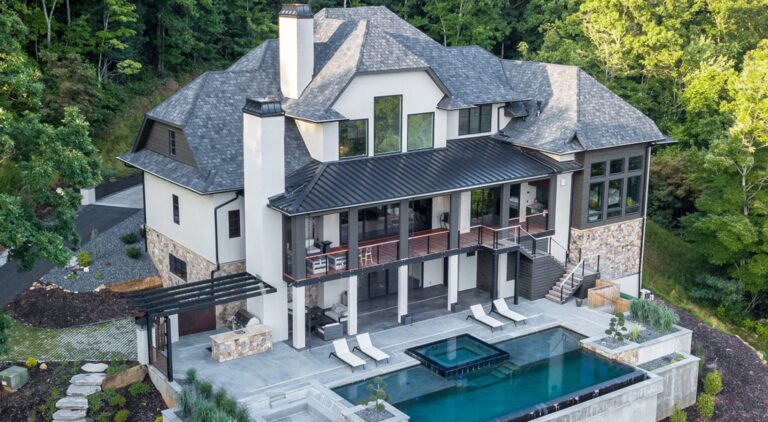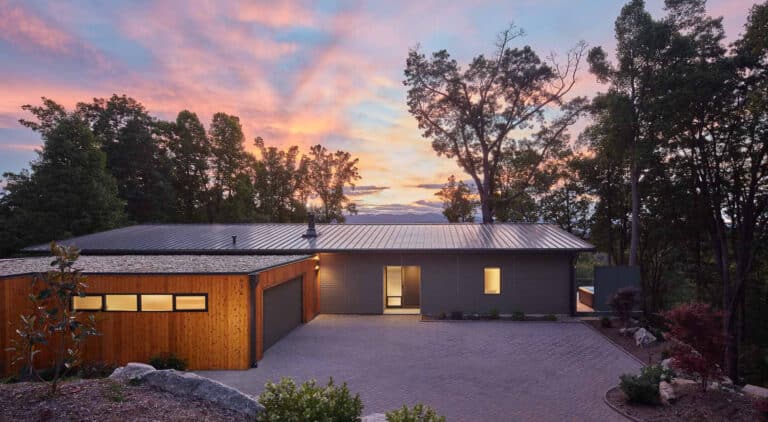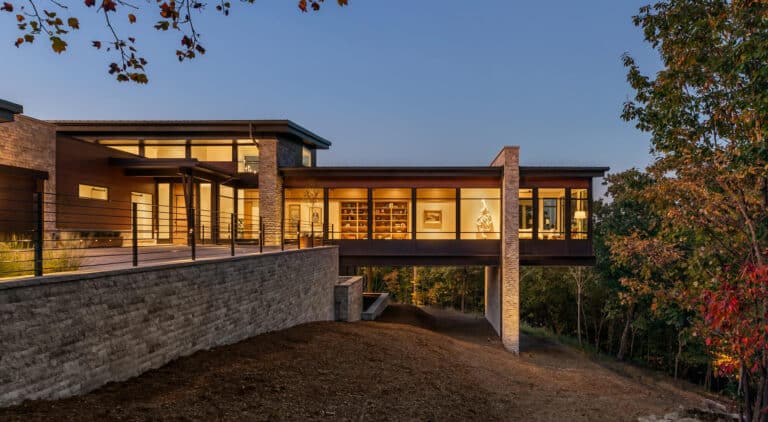Arts & Crafts is an international art and architecture movement that dates back to the late nineteenth and early twentieth centuries. It moved from the UK, throughout Europe and to the US, and it’s characterized by natural materials, functionality, expert craftsmanship, and horizontal lines. In addition to architecture, the original movement consisted of furniture, pottery, and jewelry.
The architecture of the Arts & Craft Movement, which includes the houses that today are commonly described as “craftsman,” varied from region to region. But overall, the style was generally premised on clean lines and accessibility. This movement thrived in Asheville, where today there are still many historic Arts & Craft bungalows, as well as many modern Arts & Crafts homes. Since 1987, the National Arts & Craft Conference has been held at Asheville’s Grove Park Inn. Built in 1913, the Grove Park is considered one of the finest examples of historical Arts & Craft architecture in the country.
The Architectural History of Asheville’s Grove Park Inn
The facade of Asheville’s Grove Park Inn is covered with raw granite, hand-hewn from the nearby Sunset Mountain. In keeping with the tenants of the Arts & Craft Movement, not only was the hotel built with locally available natural materials, it was designed to complement and accommodate the landscape, rather than to impose on it. This meant that Grove Park was constructed in five levels, stair-stepping its way up a mountain.

Grove Park has sheltered presidents, first ladies, entrepreneurs, and great writers. Some of its guests have included Eleanor Roosevelt, President Woodrow Wilson, Henry Ford, John D. Rockefeller, and F. Scott Fitzgerald. And the Inn still has one of the largest collections of Arts & Crafts furniture in the world.
What is Arts & Crafts?
The Arts and Crafts Movement arose in England in an era that shared some commonalities with the US today. This may be why, in recent decades, Craftsman style homes (one of the most prevalent styles from the Arts & Crafts Movement) have become the most popular residential style in the US, according to a poll conducted by the real estate website Trulia.
Craftsman style homes hold their value well. They’re so beloved that turnover is slow, and they’re relatively rare in the housing market. If you have your heart set on a Craftsman style home, your best bet is probably to custom-build.

The Arts & Crafts Movement has its roots in the Industrial Revolution—or rather, it began as a backlash to the Industrial Revolution. The movement was a rebellion against the machine-made, mass-production that the Industrial Revolution made possible. It was a return to “handmade” work, artisanship, and craftsmanship, with an emphasis on natural materials. The movement arose in response to anxieties about modern life and capitalism and represented a yearning for earlier, “simpler” times.
Adherents to the Arts & Crafts Movement critiqued excessive ornamentation that didn’t serve any functional purpose. “Have nothing in your houses that you do not know to be useful or believe to be beautiful,” said William Morris, the British father of the movement. Arts & Crafts was essentially an intelligent design push that privileged the inherent dignity of materials.
Today, in the midst of folk and outsider art museums, homesteading lifestyle blogs, craft fairs, and the rediscovery and fresh heralding of old skills—such as quilt making, canning, and carpentry— it’s strange to think that some of these same “are we so tech-y we’re losing touch?” conversations were occurring nearly 150 years ago. Even way back then, a swath of the population was fed-up with the (at that time) roughly century-old trend towards automation.
In 1887, the Arts & Craft Exhibition Society was formed in London. This collection of like-minded designers gave the movement its name. In the UK, the Arts & Crafts Movement arose in conjunction with other cultural phenomena—a return to rural living, the garden-city movement (an urban planning philosophy that gave us urban green spaces), and a folk music revival.
In the US, Arts & Craft art and architecture was considered the aesthetic complement to a progressive political movement then taking hold of the northeast. At the first American Arts & Crafts Exhibition in Boston in 1897, half of the thousand objects on display were created by women. A few Arts & Craft utopian societies formed—communities of craftspeople who sold their handiwork.
In 1901, a furniture-maker and stonemason from Wisconsin, named Gustav Stickley, began publishing The Craftsman, a magazine that encouraged readers to build and furnish their own homes using local materials. The magazine provided free house plans. Initially, “craftsman style,” referred exclusively to homes built from these plans. Eventually, however, the term came to encompass all houses with Arts & Craft style facades and characteristics.
Later, companies such as Sears and Aladdin Home began to ship do-it-yourself home “kits” to consumers. Often these kit homes borrowed craftsman design elements, which is ironic, since the kits represent the mass manufacturing that the Arts & Crafts Movement rallied against. Of course, the kits also represents the get-your-hands dirty ethos the movement promoted.
What Does Arts & Craft Architecture Look Like?
The Arts & Crafts Movement had distinct regional markers. The Prairie School Style (low-pitched roofs, overhanging eaves), propagated by Frank Lloyd Wright, and California’s ever-present bungalow style both fall under the American Arts & Craft Movement.
Craftsman houses and bungalows generally have horizontal rather than vertical lines. They’re characterized by gabled roofs, prominent eaves, abundant windows, covered porches, and tapered columns. Historically, they have stained wooden shingles or facades made of stucco or stone and are painted earthy colors with contrasting trim.

The interiors of Arts & Crafts homes are often marked by large fireplaces, exposed beams, and built-in cabinets and shelves. The built-ins efficiently use space, while more fully incorporating furnishings into design.
At Bluestone Construction, we love building Arts & Crafts homes, because we appreciate the efficiency of the design and the emphasis on working with nature.
The design of this sprawling Hendersonville home was inspired by the West Virginia-raised brothers, Charles Sumner and Henry Mather Greene. After graduating from MIT with architecture degrees, the brothers moved to California and pioneered the bungalow style.

In honoring the Arts & Crafts tenet of native materials, we used quarter-sawn white oak for the flooring throughout this home. (White Oak is a very common tree in this area). We also used cut stone, to complement the home’s mountain setting.
We love how the multiple sets of windows and stacked back-porches encourage integration with the outdoors in the living spaces. This home truly exists in harmony with its setting—and that’s something we appreciate, both as artisans and as North Carolinians.

If you’re dreaming of building an Arts & Crafts home, check out our portfolio for inspiration. And if you’re looking to remodel a historic Arts & Crafts home, well, we just won a remodeling award.
If you want a functional and gorgeous legacy home that can be passed through your family for generations, or a comfortable and beautiful home with a high resale value, you can’t go wrong with a custom-built Arts & Craft house.




